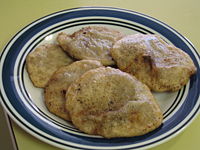
Khuushuur
Encyclopedia

Dumpling
Dumplings are cooked balls of dough. They are based on flour, potatoes or bread, and may include meat, fish, vegetables, or sweets. They may be cooked by boiling, steaming, simmering, frying, or baking. They may have a filling, or there may be other ingredients mixed into the dough. Dumplings may...
popular in Mongolia
Mongolia
Mongolia is a landlocked country in East and Central Asia. It is bordered by Russia to the north and China to the south, east and west. Although Mongolia does not share a border with Kazakhstan, its western-most point is only from Kazakhstan's eastern tip. Ulan Bator, the capital and largest...
, similar to Russian
Russian cuisine
Russian cuisine is diverse, as Russia is the largest country in the world. Russian cuisine derives its varied character from the vast and multi-cultural expanse of Russia. Its foundations were laid by the peasant food of the rural population in an often harsh climate, with a combination of...
and other cuisines' chiburekki
Chiburekki
Chiburekki is a fried turnover with a filling of ground or minced meat and onions. It is similar to the peremech of the Volga Tatars, but made with a single round piece of dough folded over the filling in a half-moon shape...
. The meat, either beef
Beef
Beef is the culinary name for meat from bovines, especially domestic cattle. Beef can be harvested from cows, bulls, heifers or steers. It is one of the principal meats used in the cuisine of the Middle East , Australia, Argentina, Brazil, Europe and the United States, and is also important in...
or mutton, is ground up and mixed with onion (or garlic) salt and other spices. The cook rolls the dough into circles, then places the meat inside the dough and folds the dough in half, creating a flat half-circular pocket. The cook then closes the pockets by pressing the edges together. A variety of khuushuur has a round shape made by pressing the dough and mince together using the dough roller.
After making the pockets, the cook fries them in oil until the dough turns a golden brown. The khuushuur is then served hot, and can be eaten by hand.
This type of Mongolian cuisine is similar to buuz
Buuz
Buuz are a type of Mongolian steamed dumpling filled with minced mutton, or beef meat. The meat is flavoured with onion or garlic and salted. Occasionally, they are flavoured with sprouted fennel seeds and other seasonal herbs...
in that the meat is prepared in the same way and cooked in a dough pocket, the principal difference being that buuz is steamed instead of fried.
Some Mongolians hold the fresh khuushuur between their palms and also with the tips of all fingers to stimulate the nerves and blood circulation in the hands. This is believed to be curative. In some occasions, a hot khuushuur is placed on the soles of the feet and other selected places to treat neurosis and health conditions related to the balance of the air element of the five elements composing the human body.

